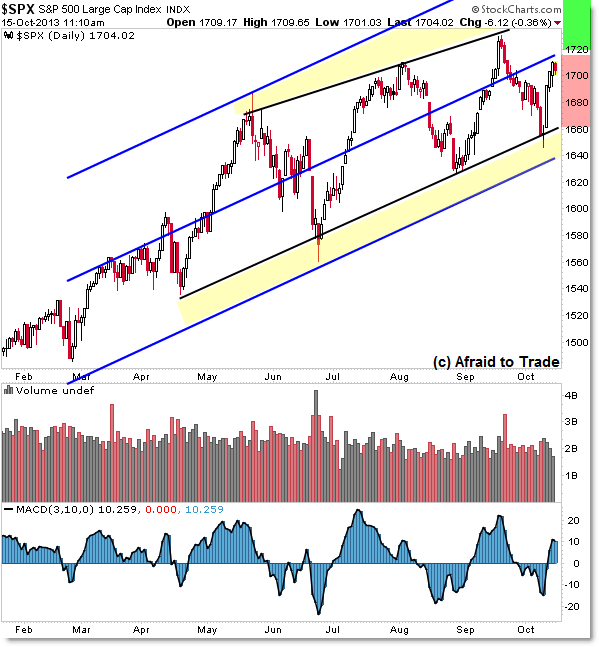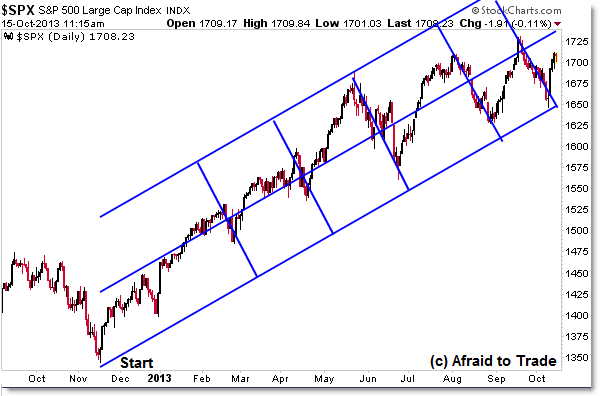SP500 Linear Regression Chart and Trade Level Update
In the previous update about the “Trendline and Target Planning for the SP500,” we noted the index was at a critical inflection point and likely to reverse higher off the confluence support target to continue the lengthy uptrend in progress.
I think we can all say that the market successful achieved its “support-bounce” goal better than would be expected with a series of three strong intraday Trend Days in a row straight up off the inflection point target.
Let’s take a slightly different update with this post and note the larger Linear Regression Chart along with a focus on the “midpoint” of the rising range pattern already in motion.

For perspective, the Blue Line is the Raff Linear Regression tool on StockCharts beginning with the small inflection low of March and ending with October 15th’s price action.
The Linear Regression Tool is not an auto-trendline tool and we can see that it stretches to encompass the ‘spikes’ of May’s high and June’s low.
The main idea here is the Midpoint of the indicator which intersects today’s price action just shy of 1,720. This will be our focal point for planning the next ‘swing’ or next few trading sessions.
I drew the more appropriate black trendlines which connect more price points (highs and lows) which I described in more detail in the Trendline and Target Planning for the SP500 post last week (use it as a reference and to apply ‘forward-walk’ analysis now that we know price did indeed bounce up off the confluence support level).
For simple planning, a clean breakthrough above the 1,720 level suggests the market could easily trade once again to new all-time highs beyond the 1,730 level into the 1,755 upper trendline of the rising rectangle pattern (probably not to the upper projection of the Linear Regression, at least not without a retracement swing first).
Speaking of retracements, let’s look at a customized view of the larger Linear Regression Channel:

This time I used the same Raff Linear Regression tool with the more distant November 2012 low and again ended with today’s date (as long as the uptrend continues, we will continue to extend the regression tool).
The updated or longer-term tool shows slightly wider boundaries and a higher Midpoint into 1,730.
What’s more important here is the angled trendlines I drew which makes the trend look like a series of boxes or windows.
These angled lines represent Retracement or Correction phases against the prevailing “Triple Timeframe” uptrend or Bull Market in motion.
With this perspective, we can see roughly how long a bull market or pro-trend phase lasts (along with a corrective phase) along with a rough estimate of time between corrective phases.
In simple terms, we can see a relatively rhythmic period of uptrending or pro-trend phases that has remained eerily consistent with the exception of the longer bull market (pro-trend) swing from July to August.
In fact, the pro-trend phase from March to April was almost identical in time (between corrections) to the May to June period.
We just ended the September to October corrective phase and may be in another pro-trend ‘window’ of the bull market in motion. If so, the next swing would be expected to continue to the 1,755 confluence as a possible upside projection target.
For now (short-term), continue to focus both on the 1,715 “Midpoint” of the trendline pattern along with the larger “Rising Rectangle” or “Rising Range” pattern in motion.
I’ll be discussing breakout, retracement, and reversal trading tactics live at the Las Vegas Traders Expo on November 22 – join me and your fellow traders at the free expo!
Corey Rosenbloom, CMT
Afraid to Trade.com
Follow Corey on Twitter: http://twitter.com/afraidtotrade
Corey’s new book The Complete Trading Course (Wiley Finance) is now available along with the newly released Profiting from the Life Cycle of a Stock Trend presentation (also from Wiley).

6 Comments
Comments are closed.